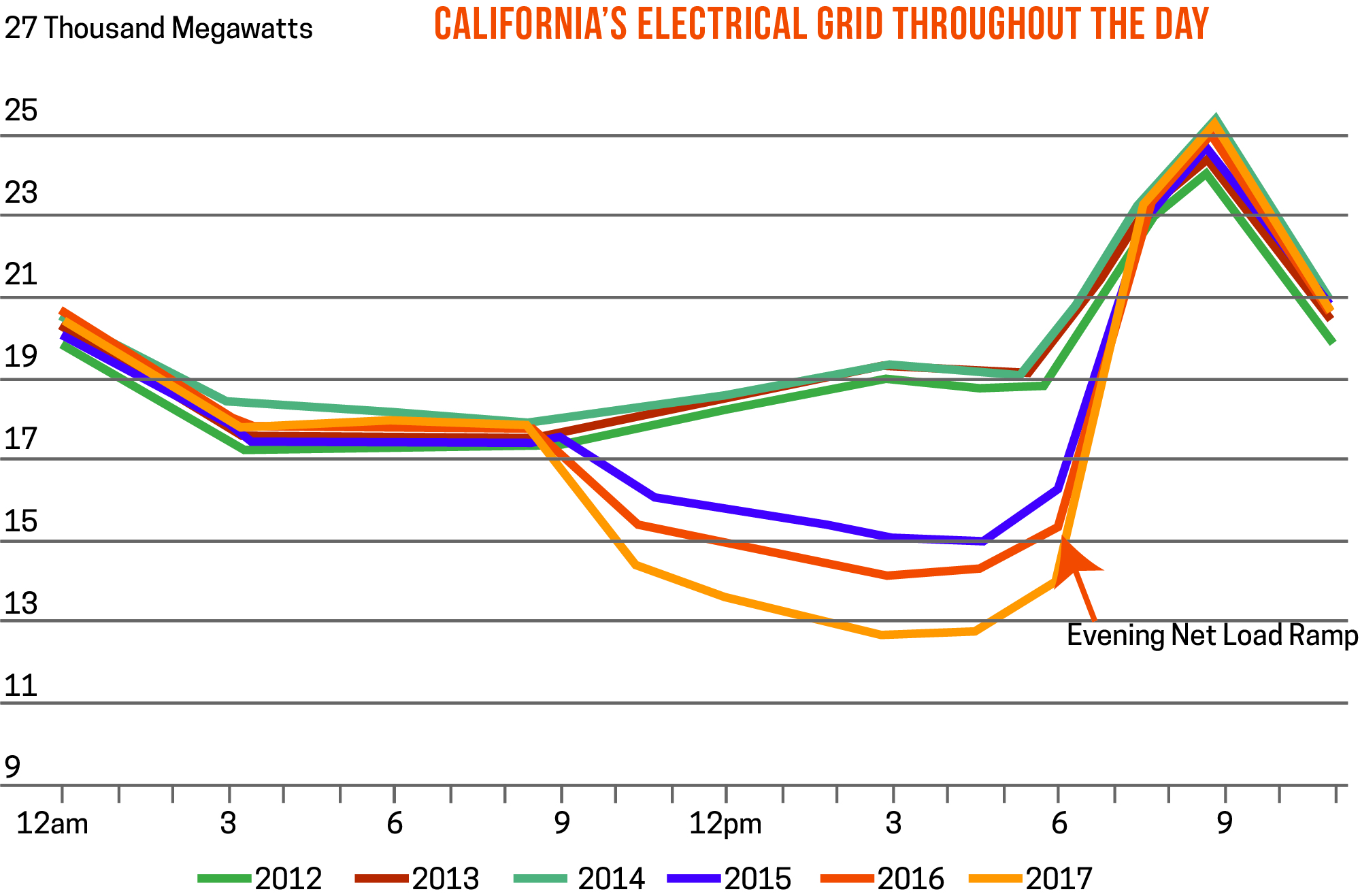Seasonal Readiness 2020
Webinar: State of the California Energy Market (State of the Energy Markets Series)
SOTM 2019 Webinar Series
The best way to manage your energy in California? Be Flexible.
In the near future, organizations with flexible resources at their disposal will have an advantage when it comes to earning money for helping the grid.
California is committed to integrating renewables into its electrical grid. The load-shift product is set to launch in November 2019. In its wake, expect a series of flexible resource products to be proposed, reviewed, and eventually launched.
The next generation load shift product and any subsequent flexible resource products will likely be technology-neutral, meaning customer loads will be able to participate as long as customers can curtail on-demand and respond to short-term curtailment windows.
When it comes to demand-side energy planning, California’s legislative arm is forward-thinking, investing in the infrastructure and systems needed to reach the state’s ambitious goals.
For now, commercial and industrial customers are a different story.
Many organizations simply have not yet made the kind of investments in specialized equipment or automation needed to optimize their participation in the kind of programs California is looking to introduce.
Whether or not to embark on a system upgrade is a cost/benefit analysis large California organizations would be wise to consider.
In the very near future, there is going to be a potentially significant earning opportunity for organizations that can quickly dispatch flexible resources when the grid is stressed or market prices are exceedingly high.
Organizations that are open to automation and have made the right investments their systems are going to be the ones capable of performing and will reap the rewards for keeping the California grid reliable.
This post was excerpted from the 2019 State of Demand-Side Energy Management in North America, a market-by-market analysis of the issues and trends the experts at CPower feel organizations like yours need to know to make better decisions about your energy use and spend.
CPower has taken the pain out of painstaking detail, leaving a comprehensive but easy-to-understand bed of insights and ideas to help you make sense of demand-side energy’s quickly-evolving landscape.
Has California finally solved “The Duck Curve?”
California experiences a daily spike in energy demand in the early evening when renewable sources like solar go offline and residents come home from work and increase their energy consumption by flipping on their air conditioning, turning on their lighting, doing laundry, charging electronic devices, and engaging in other energy-consuming activities.
When charted on a graph (see picture), the shape of California’s daily electrical consumption resembles a duck. Analysts have noted the duck’s belly is getting fatter with each passing year, meaning the evening net load ramp when flexible resources are needed to account for the spike is becoming more extreme.

A Steady Diet of Storage
The duck’s belly may not get fatter in 2019, but it’s still going to be heavy.
To help alleviate grid stress associated with evening load ramp, CAISO is developing a load-shifting product under the third phase of CAISO’s Energy Storage Distributed Energy Resource (ESDER) that would be the state’s first product that will pay a resource to consume energy to soak up excess generation during negative pricing periods.
CAISO’s load-shift program embodies California’s desire to bring clean resources to the forefront of grid reliability by storing excess clean energy and making it available for future use.
The program, championed by the California Energy Storage Alliance (CESA) among other energy storage companies, also aims to reduce the number of solar curtailments needed to offset the ill effects of negative pricing caused by a large solar surplus on CAISO’s system.
The two big questions on the minds of organizations that have implemented or are thinking of implementing energy storage are:
- When will the CAISO’s load shifting product be available for participation?
- How will these storage resources be valued in the wholesale market?
The short answer to the first question is the program is currently going through the FERC approval process and is scheduled to go into effect in November 2020.
As far as how storage will be valued in the wholesale market? It’s too early to tell right now, but expect California to continue to work to provide value for all the services storage can provide.
This post was excerpted from the 2019 State of Demand-Side Energy Management in North America, a market-by-market analysis of the issues and trends the experts at CPower feel organizations like yours need to know to make better decisions about your energy use and spend.
CPower has taken the pain out of painstaking detail, leaving a comprehensive but easy-to-understand bed of insights and ideas to help you make sense of demand-side energy’s quickly-evolving landscape.
Now What? California Demand Response in a Post-Fossil Fuels World
The clock has started ticking down on backup generators in California’s demand response programs. On January 1, 2019, the California Public Utilities Commission’s Demand Response Prohibited Resources decision officially takes effect. The decision (officially Decision 16-09-056) mandates that fossil-fueled resources can no longer be used to provide demand response.
The decision doesn’t remove fossil fuel generators from use for backup or for facility power generation, just from demand response (DR). It’s clear, though, that they face near-certain elimination from the California power landscape in the near future. The historic green energy bill signed by Gov. Jerry Brown on September 10th, 2018, specifically requires that 50 percent of California’s electricity be powered by renewable resources by 2026—seven short years away.
Needless to say, this has some profound implications for the future of distributed energy resources (DERs) and DR in the nation’s most populous state (and the world’s fifth largest economy). California’s “bold path” toward 100 percent zero-carbon electricity by 2045 will take it through uncharted territory potentially full of threats to the reliability of its far-flung electrical grid and the costs of the electricity it provides.
Demand response in California, as elsewhere in the country, has been a valuable tool in managing demand-side energy use, protecting the grid, and funding progressive sustainability initiatives. Generators have been a valuable part of DR, providing additional opportunities to save and earn as part of their commitment to a balanced California grid. But California has long been strict on the use of non-emergency generation for demand response, and the green energy bill tightens restrictions to an outright ban.
With fossil-fuel generators permanently pulled from DR participation in California, then, the question facing participants is, “Now what?” There are no easy answers—in a constantly evolving energy universe like California’s, there never are. That said, CPower recommends a couple of steps you can take to ease your transition into a post-fossil fuel world and continue to save and earn.
No Generators? No Problem.
The 2015 court ruling that vacated the EPA’s rule—referred to in the industry as “the Vacatur”—took effect in 2016 and upended DR participation. Hundreds of fossil-fuel backup generators were withdrawn from DR programs in most of the nation’s wholesale energy markets
One water agency, though, found they could still successfully participate in DR without their generators. Virginia’s Lake Gaston Water Supply Pipeline supplies water to Virginia Beach, the state’s most populous city. The Vacatur forced them to withdraw their diesel-powered generators from their DR program. Without the generator to sustain pumping during curtailment as part of DR, they faced the prospect of not being able to curtail the required power during an event, which meant pulling out of DR completely.
Working with CPower, Lake Gaston’s curtailment service provider since 2010, managers were able to research new methods of DR participation without generators. These measures included a full pump shutdown, something they weren’t sure they could do successfully. After a thorough analysis and review of their operations with CPower, it turned out that they could. Read the full story here.
Back to Basics
Before you mourn kilowatts lost, take a moment and consider if there are kilowatts to be found to replace them. Start by asking yourself, “What’s changed since I received my first demand response check?” The answer might be, “Everything,” or something close to it.
How have your day-to-day operations changed in response to changing market conditions? What upgrades have you made to your lighting, HVAC, IT, security, and communications? Is your physical space smaller or bigger? Have you added locations? What’s the state of your building envelope? Is it sufficiently insulated? Has on-site staffing grown or declined?
These are questions to be answered when you have a knowledgeable energy engineer, like those at CPower, conduct a thorough assessment of your facility. Your new “deep dive” assessment forms the foundation for creating a new curtailment action plan, one that matches your available kilowatts to available demand response and demand-side energy management programs. Chances are you’ll find new kilowatts to replace those lost from removed generators, and possibly more.
Dollars for DERs
Now is the perfect time to think beyond the generator and embrace other dispatchable distributed energy resources, or DERs, for your backup power. Behind-the-meter technology like storage batteries—charged by renewable but intermittent resources like sun and wind as well as grid energy—can be enrolled by CPower in California’s demand response programs (Capacity Bidding Program, Base Interruptible Program, and Demand Response Auction Mechanism aka DRAM) as available generation to help when the grid is stressed. You can combine your DER asset with demand response programs to offset kWs lost from generators.
For example: California State University, Dominguez Hills is one of the most sustainability-focused campuses in the state system. In 2017, CSUDH joined with CPower and Stem, provider of the school’s 1 MW intelligent storage system, to create a combined curtailment and storage program. By stacking these technologies, CSUDH significantly reduced their environmental footprint, provided approximately 400 kW of grid relief, and generated revenue that flows back to the school to fund further sustainability initiatives. For their efforts, CSU was also recognized with the 2018 Smart Energy Decisions Innovation Award for Customer Project/Onsite Renewable Energy.
What’s Next?
As California moves toward 100% zero-carbon energy, it’s safe to say that fossil-fuel generation, on both the micro and macro level, will continue to be phased out. Demand response, however, will continue to have an important role in California’s energy re-imagining. Demand response continues to fulfill its primary role, protecting the grid of the world’s fifth largest economy. Look for thought leaders and decision makers to find new and better ways to integrate renewables and dispatchable renewable energy resources into statewide demand-side energy management programs. And look for CPower to continue to advocate on behalf of our customers to ensure their ability to save and earn while protecting the grid.
Green Buildings Attract Happy Tenants and Bring Green Earnings to the Commercial Real Estate Industry
The following is an excerpt from “Monetizing Energy Assets in the Commercial Real Estate Industry: A Complete Guide for Earning Revenue with demand-side energy management” by CPower:
For the past several years, the economic and policy climate of North America has created an impetus for green and sustainable energy-efficient buildings. The commercial real estate (CRE) industry has contributed to this momentum.
Keeping the supreme goal of providing a great tenant experience at the forefront of their operations, commercial real estate facility managers and executives are increasing their focus on energy management plans rooted in a sustainable building philosophy based on cost-effectiveness and energy-optimization.
The CRE industry’s current push toward a more efficient and sustainable future comes at a serendipitous time when energy markets around the country are working to integrate distributed energy resources (DERs) onto their energy grids in an attempt to diversify their fuel mixes.
Right now and for the foreseeable future, grid operators and electric utilities in each of the nation’s six deregulated energy markets have created a wealth of incentive programs to encourage commercial and industrial organizations to help integrate their grids with distributed energy.
CRE organizations with distributed resources at their facilities like backup generators, solar photovoltaic cells, fuel cells, energy storage and more are therefore in a position to reap significant financial benefits by working with a properly licensed company that can help them monetize their existing energy assets.
The Importance of Tenant Experience
No two commercial buildings are alike and every commercial real estate organization is unique. One trait CRE organization’s share, however, is the unwavering desire to provide a great experience for their tenants.
More and more commercial real estate companies are realizing that sound demand-side energy management–the practice of modifying consumer demand for energy–can play an integral part in providing a great tenant experience.
Without satisfied tenants, of course, the CRE industry wouldn’t exist. That’s why every measure a CRE organization explores concerning energy management should be examined through the tenant-experience lens.
Demand for Green Buildings
Utility costs related to energy, water, and waste have a significant impact on a CRE organization’s profits. For decades, CRE organizations have sought to reduce these impacts by making their buildings more efficient and (if at all possible) environmentally friendly.
Green buildings–those which are environmentally responsible and resource-efficient–are estimated to consume 30-50% less energy than non-green buildings. Green buildings also use an average of 40% less water, emit 30-40% less carbon-dioxide, and produce 70% less solid waste.
Green Buildings, Happy Tenants
In the last several years, CRE organizations across North America have recognized the direct correlation between green buildings and tenant attraction.
The increasing popularity of green leases, which include an up-front establishment of sustainability goals and allocation of implementation responsibilities between the owner and the tenant, is proof that the notion of sustainability is a value shared between CRE organizations and the tenants they serve.
Since the Great Recession, many tenants’ business performance has been and continues to be evaluated by customers and investors looking at aspects beyond the strictly-financial. Tenants want to tell the story of their operating in a green building that actively pursues sustainability efforts with a positive effect on the community and the environment.
CRE organizations who oblige will not only provide a superior tenant experience, they’ll also be in a position to monetize their efforts through demand-side energy management.
Energy Assets in the CRE Industry
CRE Organizations that have made their buildings more energy efficient–whether by lighting upgrades, HVAC improvement, or any other measure, may be eligible to earn money for the permanent reduction of their electric demand.
They may already possess energy assets like back-up generators, energy storage, solar generation, and more that can also earn revenue through demand-side energy management.
Getting started
When selecting a company to guide your demand-side energy management, it’s important to consider the company’s scope of demand-side expertise. Do they serve the markets where your properties reside? Does the company specialize in one type of demand-side energy management, or is it equally skilled in a wide range of energy asset monetization practices?
Most importantly, a demand-side energy management partner should earn your trust in every aspect of the relationship your organizations share.
Demand-side energy management is not a one-size-fits-all exercise. No two buildings are alike and every CRE organization is unique in its complexities.
Like your business, your demand-side energy management strategy should evolve and refine over time, forever in pursuit of perfection as energy markets continue to change and your needs as an organization evolve.
Visit https://cpowerenergy.com/commercial-reit-lp to learn more about CPower’s extensive experience in the commercial real estate industry, including how Tishman Speyer Commercial Real Estate earned more than $1.4 million through demand-side management with CPower as their guide.
To read the entirety of “Monetizing Energy Assets in the Commercial Real Estate Industry: A Complete Guide for Earning Revenue with demand-side energy management” click HERE.
Case Study: Desert Water Agency
2.5 MW of monthly demand response commitment gives the Desert Water Agency energy savings and additional revenue to offset costs.
The Customer: Desert Water Agency, Palm Springs, California
The Desert Water Agency (DWA) is a not for profit government agency providing water to the desert resort community of Palm Springs, in the Coachella Valley, as well as adjacent areas. Nearly all of the water that is used in the Coachella Valley comes from a groundwater basin, or aquifer estimated to contain about 30 million acre-feet of water. DWA pumps water using 29 wells spread throughout its retail area and delivers it to 23,000 water connections serving approximately 106,000 residents and businesses.
DWA embraces sustainable energy resources, including hydroelectric and solar, to power its pumps and generate energy savings. A solar field comprising 4,500 ground-mounted fixed tilt panels produces just over a megawatt of energy. The solar facility powers their Operations Center and Water Reclamation Plant and is projected to save the Agency and its ratepayers about $6 million in energy costs during its lifetime.
The Challenge: Tap the Demand Response Revenue Stream
The demand response program offered by CPower pays customers for reducing their energy usage upon same-day notification of a possible grid event. DWA understands the benefit of earning additional revenue by curtailing their power load and using that revenue to further offset energy costs. The key to DWA’s successful participation was technically implementing a curtailment program with the least possible disruption to its operations and its customers. Wells throughout the city that could participate in the program would be turned off when CPower issues a curtailment notification.
That left them with one important question: “Can we survive three to four hours of having wells shut down and still be able to refill our reservoirs to meet customer demand?”
The CPowered Strategy: One Well at a Time
Thankfully, with CPower’s help, the answer was “Yes.”
DWA chose CPower as their demand response provider to manage their participation in the demand response program. CPower provides a team of energy experts to review the Agency’s operations and energy goals. Together, DWA and CPower developed an energy management strategy that gives DWA the tools to optimize their participation in the program.
The strategy called for DWA to start with a small number of wells, to familiarize themselves with the curtailment process with minimal impact on day-to-day operations. As DWA’s staff became more comfortable with the process, more wells were added, until all eligible wells—25 of their total of 29—are now actively participating and generating revenue for the Agency.
“The CPower relationship has been outstanding… I fully trust them. The integrity is always there, they are always reliable and very knowledgeable.”
-Steve Johnson, Assistant General Manager
CPowered Solutions: Power Empowerment
Understanding the Agency’s preference for autonomy over automation, CPower empowered it with the tools to control its energy spend and demand response participation. The Agency can turn individual sites on and off at will upon notification through their supervisory control and data acquisition (SCADA) software to implement the custom-designed energy strategy developed with CPower’s experts. Perhaps best of all, the Agency can manage it all from their central Operations Center, without dispatching staff to well sites under a grid-stressing desert sun.
CPower collects utility meter data for each of DWA’s sites and supplies them with quarterly performance data. These data provide DWA with an understanding of each site’s base load value. The Agency can use these data to decide their optimum load curtailment commitment for each month of the program.
The Results: An Oasis of Cost-Saving Revenue
DWA typically nominates a changing rotation of eight wells each month into the program. The total monthly load drop amounts to about 2.5 MW. This is a significant commitment that helps relieve stress on the electric grid.
The program also provides DWA significant financial incentive for their participation. During a recent six-month period, May-October, they received $105,872.68 in payments for their participation. These incentives allowed them to further offset their energy costs, to the benefit of their customers.
Just as importantly, perhaps, DWA enjoys the total commitment of CPower’s dedicated California energy market experts. The Agency knows from experience that CPower will support their energy goals at every turn, with an energy strategy custom-made to meet their unique requirements.
Download a PDF version of this case study
How to Maximize Demand Response Earnings with California’s DRAM Program
For most of the last two decades, demand response in California has been largely procured and operated by the state’s electric utilities.
That trend is changing.
Demand response in California is currently experiencing significant changes as regulators implement measures to expand the state’s pool of energy resources and assimilate these resources with the California Independent System Operator’s (CAISO) markets.
This regulatory reform has created new opportunities in California for demand response programs, which pay businesses for using less energy when the grid is stressed or electricity prices are high.
The Demand Response Auction Mechanism
The Demand Response Auction Mechanism (DRAM) was developed in 2014 under the guidance of the California Public Utility Commission (CPUC) in an effort to harmonize utility-based reliability demand response with CAISO, the state’s grid operator.
In December 2014, the Commission issued D. 14-12-024 which requires the state’s IOUs: Southern California Edison Company (SCE), San Diego Gas & Electric Company (SDG&E) and Pacific Gas and Electric Company (PG&E) to design and implement Demand Response Auction Mechanism (DRAM) pilot programs in 2015 for 2016 capacity (DRAM I or 2015 DRAM) and in 2016 for 2017 capacity (DRAM II or 2017 DRAM). The three utilities recently completed a solicitation for 2018/2019 capacity (DRAM III) procuring over 200 MW of DR resources across the state.
Now in its third year, the program seeks to allow CAISO to add reliable demand response resources to areas of California where electric reliability may be at risk.
DRAM is a pay-as-bid program with three goals:
1)Fully integrate DR resources with the CAISO energy market
2) Test whether third parties can bring these resources to the table without structured utility programs
3) Allow residential resources to participate directly in the CAISO markets
The DRAM program also provides market participation testing from a broader base of distributed energy resources, including behind-the-meter storage. Under DRAM, these resources have the opportunity to behave not just as system capacity, but also as local and flexible resources.
California’s recent actions aim to revise the market’s existing demand response program structure and are an indication that DR has an important role to play in the state’s future.
The best way for an organization to take advantage of the DRAM program and the opportunities available in the California Market is to consult a trusted demand-side energy management company.
Such a company can evaluate an organization’s facilities and determine its curtailment capabilities. Next, they can explain in full the many demand response and demand management programs that are available in the California Market and help determine which offer the particular organization the best chance for curtailment success.
To learn more about how CPower can help your organization earn with the Demand Response Auction Mechanism program, please visit CPowerEnergy.com/dram-california.
To continue learning about how the California grid is changing to meet the needs of the future, read: The Evolution of The California Energy Market: How Demand Response and Demand Management will Play Integral Roles in The Golden State’s Energy Future












